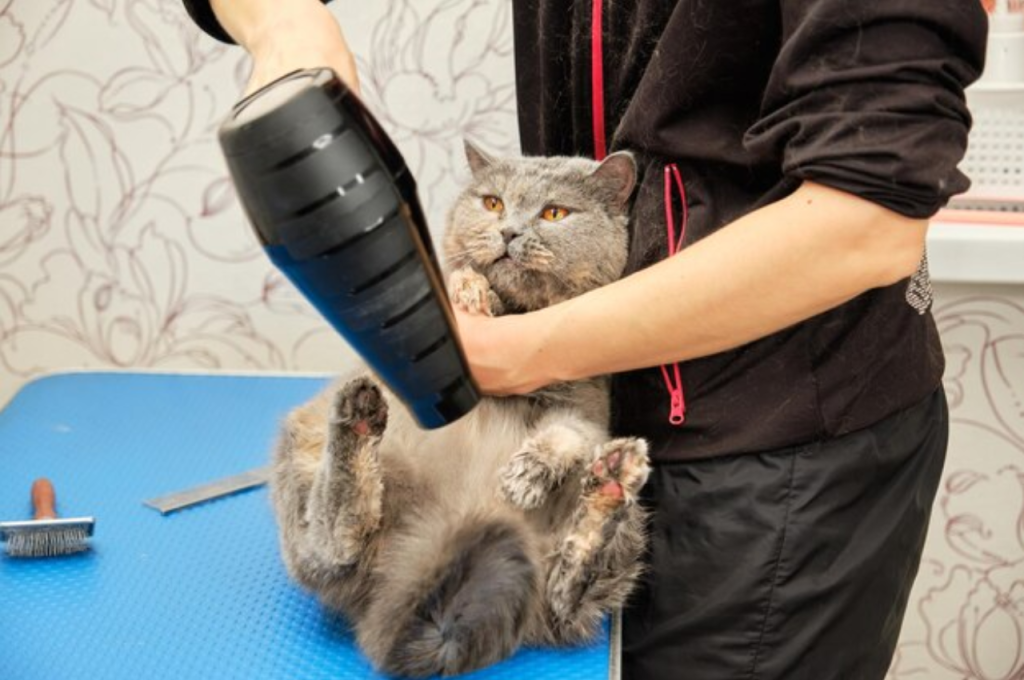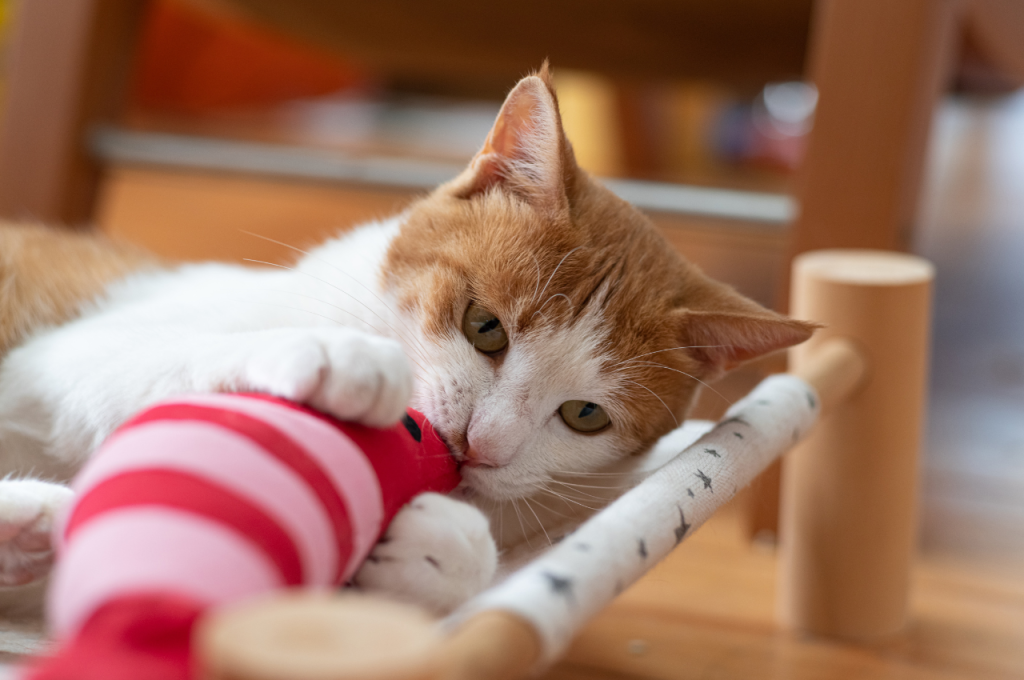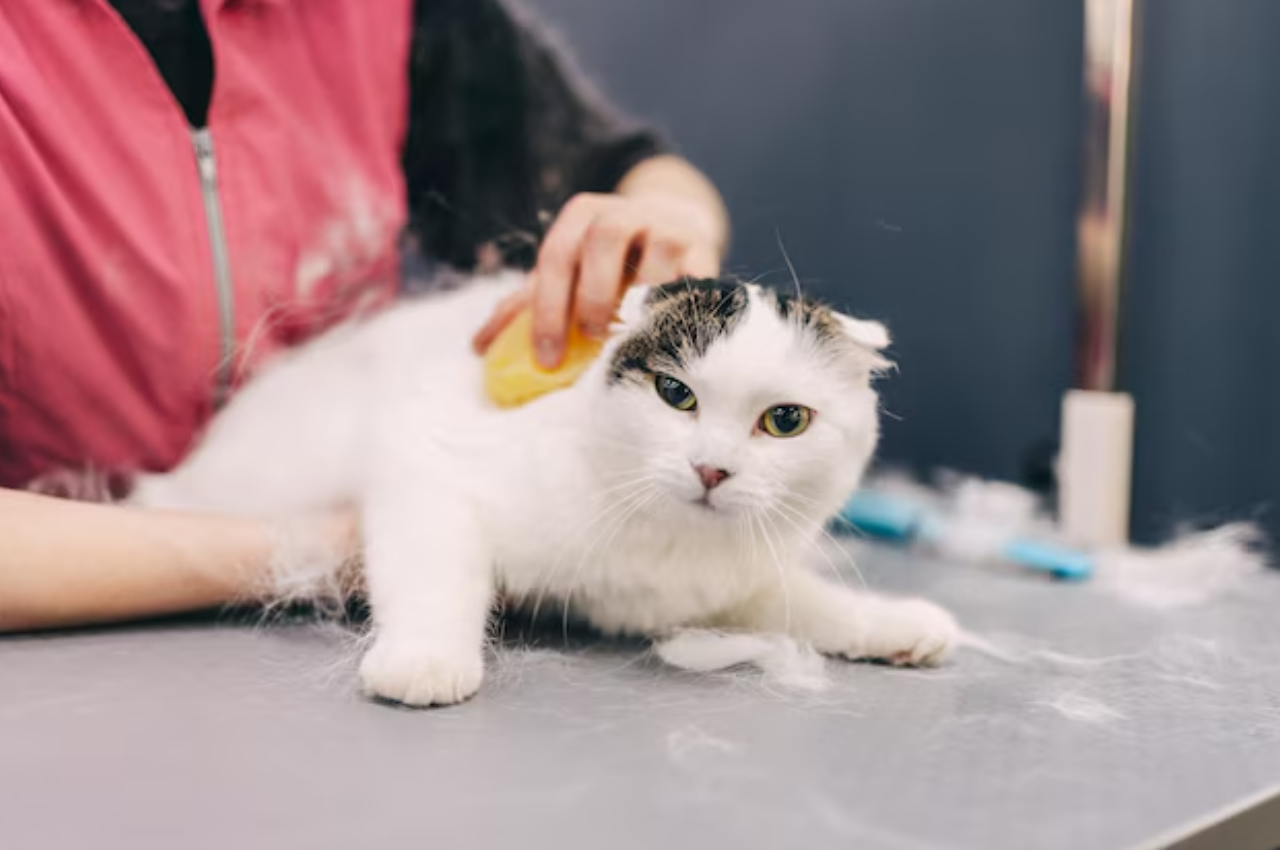To stop your cat from overgrooming, provide mental and physical stimulation through interactive toys, puzzles, and play sessions. Additionally, ensure your cat’s diet is well-balanced, and address any underlying medical conditions that may be causing stress or discomfort, as these can contribute to over grooming.
Regularly check for skin irritations or allergies, and consult a veterinarian to rule out medical causes. Creating a calm environment with hiding spots and quiet areas can also help reduce anxiety-related grooming. Consider using pheromone diffusers to soothe your cat and reduce stress. If the over grooming persists, seek advice from a veterinarian or a feline behaviorist to develop a tailored plan to address the behavior effectively.
Introduction to Feline Over Grooming
Feline over grooming, also known as psychogenic alopecia, is a behavior where cats excessively lick, bite, or chew their fur, often leading to bald patches or irritated skin. This behavior can be triggered by a variety of factors, including stress, anxiety, boredom, or underlying medical conditions like allergies or skin infections.

Over grooming is a common sign of discomfort in cats, and it often requires careful observation and intervention to identify and address the root cause. Understanding the reasons behind this behavior is essential for helping your cat return to a healthy grooming routine. If over grooming persists, consulting a veterinarian is crucial to ensure your cat’s well-being.
Recognizing Excessive Grooming
Excessive grooming in cats can be identified through various signs, such as visible hair loss, bald patches, skin irritation, and the presence of hairballs. Excessive licking or chewing on certain body parts and constant grooming are also indicators of this behavior.
Potential Causes for The Behavior
There are several potential causes for over grooming in cats, including stress, anxiety, skin allergies, parasites, and pain. Environmental changes, boredom, and underlying medical conditions can also lead to this behavior. Identifying the root cause is crucial in addressing and preventing excessive grooming in felines.
Identifying Stress Triggers
Identifying stress triggers in your cat is the first step in addressing over-grooming. Cats can over-groom as a response to stress, and recognizing the factors that cause stress in your cat can help you mitigate the issue.
Common Stressors in Cats
Understanding the common stressors in cats can help you identify potential triggers for over-grooming. These can include changes in their environment, lack of stimulation, social conflicts with other pets, or even health issues.
Environmental Changes and Cat Anxiety
Environmental changes such as moving to a new home, rearranging furniture, or introducing new pets can cause anxiety in cats, leading to over-grooming. Providing a stable and enriched environment can help alleviate this stress.
Diet and Nutrition’s Role
Understanding the role of diet and nutrition is crucial in addressing your cat’s over grooming. The food your cat consumes plays a significant role in their overall health, including their skin and coat condition.
Allergies and Food Sensitivities
Cats can develop allergies or food sensitivities, leading to skin issues and excessive grooming. Identifying and eliminating potential allergens from their diet can help alleviate these problems.
Optimizing Your Cat’s Diet for Skin Health
Ensuring your cat’s diet is rich in essential nutrients, such as omega-3 fatty acids and high-quality proteins, can promote healthy skin and reduce the urge to over groom.
Creating a Soothing Environment
Create a calming space for your cat to prevent over-grooming by providing interactive toys and scratching posts. Offer a balanced diet and regular grooming sessions to reduce stress and potential triggers. Ensure a peaceful environment with hiding spots and cozy resting areas for your feline friend’s well-being. Creating a Soothing Environment is an essential step in preventing over-grooming in cats. It is crucial to understand that cats over-groom due to various reasons, including stress, anxiety, and boredom. Therefore, creating a peaceful and relaxing environment for your feline friend is imperative.
Safe Spaces and Hideaways
Cats love to have a space of their own where they can retreat and relax. Providing your cat with a safe space and hideaway can help to reduce stress and anxiety, which can lead to over-grooming. You can create a hideaway by placing a cardboard box in a quiet corner of your house or a cat tree near a window. It is essential to ensure that the hideaway is easily accessible and comfortable for your cat.
The Importance of Routine
Cats thrive on routine, and it is crucial to establish a daily routine for your feline friend. Establishing a routine can help to reduce anxiety and stress, which can lead to over-grooming. Ensure that your cat has a regular feeding schedule, playtime, and grooming time. This routine will help your cat feel secure and comfortable in their environment.
Other Tips to Create a Soothing Environment
In addition to safe spaces, hideaways, and routines, there are other tips to help create a soothing environment for your cat. These include:
- Providing plenty of toys and scratching posts
- Playing relaxing music or leaving a TV on for background noise
- Keeping the litter box clean and in a quiet location
- Using Feliway, a synthetic pheromone that can help to reduce stress in cats
- Providing plenty of fresh water and food
In conclusion, creating a soothing environment for your cat is crucial in preventing over-grooming. Providing safe spaces, establishing a routine, and following other tips can help to reduce stress and anxiety in your feline friend. Remember, a happy and relaxed cat is less likely to over-groom, which can lead to various health issues.
Interactive Play and Mental Stimulation
Interactive play and mental stimulation can be effective in stopping your cat from over grooming. Providing your cat with toys that encourage play and mental stimulation can distract them from excessive grooming habits. Additionally, spending more time engaging in play and interaction with your cat can help reduce stress and anxiety which can contribute to over grooming.

Toys and Games to Reduce Anxiety
Engage your cat with interactive toys to prevent over grooming. Provide puzzle feeders and catnip-filled toys for mental stimulation. Rotate toys regularly to keep interest levels high.
Bonding Time and its Benefits
Spend quality time with your cat through interactive play sessions. Groom your cat regularly to strengthen the bond. Use feather wands and fishing rod toys for interactive play. Create a safe and comfortable environment for your cat.
Medical Interventions
To address your cat’s over-grooming, consider consulting a veterinarian for medical interventions. They may recommend behavioral therapy, pheromone diffusers, or medication to alleviate stress and curb excessive grooming habits. Seeking professional advice is crucial in finding an effective solution for your cat’s well-being.
When to Consult a Veterinarian
- If over-grooming persists despite home remedies.
- If skin irritation or bald patches develop.
- If behavioral changes accompany over-grooming.
Medications and Topical Treatments
Prescribed by vets to reduce anxiety and itching. Include steroids, antidepressants, and antihistamines. Topical treatments can soothe irritated skin. Consult your vet before administering any medication. Remember to follow the vet’s instructions precisely. Monitor your cat’s response to treatment closely.
Alternative Therapies
Discover alternative therapies to help your cat stop over grooming. Explore options like aromatherapy, herbal remedies, and behavior modification techniques. These natural approaches can provide relief and promote a healthier, happier feline friend.
If your cat is over grooming, it could be a sign of stress or anxiety. While there are medications available to treat these conditions, some pet owners prefer to use alternative therapies to help their cats relax. Here are a few alternative therapies you can try to stop your cat from over grooming.
The Use of Pheromones
Pheromones are natural chemicals that cats use to communicate with each other. Synthetic versions of these chemicals can be used to help cats feel more calm and relaxed. There are a few different types of pheromones available, including:
- Feliway: This is a synthetic version of the pheromones that cats produce when they rub their faces on things. It can be used to calm cats down and reduce stress levels.
- Comfort Zone: This product contains synthetic versions of the pheromones that nursing mothers produce. It can be used to help cats feel more secure and relaxed.
Holistic Approaches to Stress Reduction
There are also a number of holistic approaches that can be used to help reduce stress in cats. Some of these include:
- Acupuncture: This ancient Chinese practice involves the insertion of thin needles into specific points on the body. It can be used to help reduce stress and anxiety in cats.
- Massage: Just like humans, cats can benefit from a good massage. Gentle stroking and kneading can help to relax your cat and reduce stress levels.
- Aromatherapy: Certain essential oils, such as lavender and chamomile, can be used to help calm cats down. However, it’s important to make sure that the oils are safe for cats before using them.
If your cat is over grooming, it’s important to address the underlying cause of the behavior. By using alternative therapies to help your cat relax, you may be able to reduce stress levels and prevent excessive grooming. However, it’s always a good idea to talk to your veterinarian before trying any new treatments.
Grooming and Coat Maintenance
To prevent your cat from over grooming, establish a regular grooming routine to keep their coat in good condition. Provide mental and physical stimulation, and address any underlying health issues that may be causing excessive grooming. Introducing environmental enrichment and interactive play can also help reduce stress and prevent over grooming.
Cats are known for their grooming habits, but when it becomes excessive, it can lead to various skin issues and hair loss. As a cat owner, it’s essential to help your feline friend maintain a healthy coat by following a regular grooming routine. In this post, we’ll cover some grooming and coat maintenance tips to help you stop your cat from over-grooming.
Regular Brushing Techniques
Brushing your cat’s coat regularly is crucial to prevent matting and skin issues. A good quality brush can help remove loose hair, dirt, and debris from your cat’s coat. It also helps to spread natural oils throughout the coat, making it soft and shiny. Here are some regular brushing techniques you can follow:
- Use a slicker brush to remove loose hair from your cat’s coat.
- Comb through your cat’s coat to remove any tangles or mats.
- Use a soft-bristled brush to massage your cat’s skin and distribute natural oils.
- Brush your cat’s fur in the direction it grows to avoid discomfort.
Preventing Matting and Skin Issues
Matting can be a painful experience for cats, and it can also lead to skin irritation and infection. Regular grooming can prevent matting and associated skin issues. Here are some tips to prevent matting and skin issues:
- Trim your cat’s hair regularly to prevent tangles and mats.
- Use a detangler spray to make brushing easier.
- Check your cat’s skin for any redness, bumps, or rashes.
- Consult with your veterinarian if you notice any skin issues.
In conclusion, regular grooming and coat maintenance can help stop your cat from over-grooming. By following the tips above, you can help your feline friend maintain a healthy coat and avoid any associated skin issues.
Monitoring and Adjusting Strategies
To prevent your cat from over grooming, it is important to monitor their behavior closely and make adjustments accordingly. Keep an eye out for any signs of stress or discomfort, provide them with stimulating toys and activities, and consider consulting with a veterinarian for further guidance.

Keeping a Behavior Diary
- Keeping track of your cat’s grooming habits can help identify patterns.
- Record the frequency and duration of grooming sessions.
- Note any changes in behavior or environment.
- Document stress triggers or changes in routine.
When to Seek Further Help
Professional assistance is necessary if over-grooming persists despite interventions.
- Consult a veterinarian for medical evaluation.
- Seek advice from a feline behaviorist for specialized help.
- Consider underlying health issues as a potential cause.
Conclusion
To wrap up, addressing the root cause of your cat’s over-grooming behavior is key. By implementing environmental enrichment, reducing stress triggers, and seeking vet advice, you can help your feline friend lead a healthier and happier life. Remember, patience and consistency are vital in breaking this habit.
